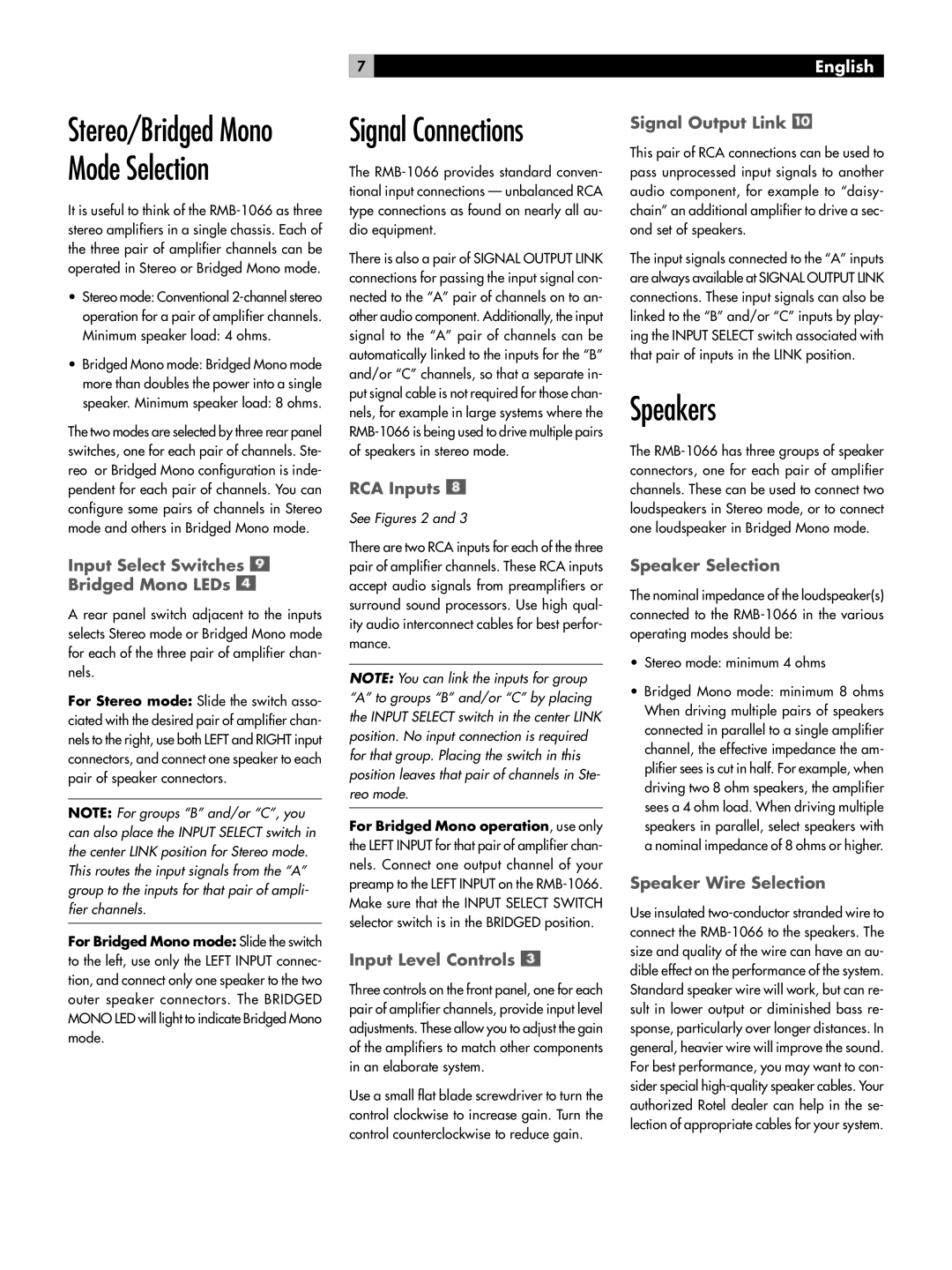
Stereo/Bridged Mono Mode Selection
It is useful to think of the
•Stereo mode: Conventional
•Bridged Mono mode: Bridged Mono mode more than doubles the power into a single speaker. Minimum speaker load: 8 ohms.
The two modes are selected by three rear panel switches, one for each pair of channels. Ste- reo or Bridged Mono configuration is inde- pendent for each pair of channels. You can configure some pairs of channels in Stereo mode and others in Bridged Mono mode.
Input Select Switches  Bridged Mono LEDs
Bridged Mono LEDs 
A rear panel switch adjacent to the inputs selects Stereo mode or Bridged Mono mode for each of the three pair of amplifier chan- nels.
For Stereo mode: Slide the switch asso- ciated with the desired pair of amplifier chan- nels to the right, use both LEFT and RIGHT input connectors, and connect one speaker to each pair of speaker connectors.
NOTE: For groups “B” and/or “C”, you can also place the INPUT SELECT switch in the center LINK position for Stereo mode. This routes the input signals from the “A” group to the inputs for that pair of ampli- fier channels.
For Bridged Mono mode: Slide the switch to the left, use only the LEFT INPUT connec- tion, and connect only one speaker to the two outer speaker connectors. The BRIDGED MONO LED will light to indicate Bridged Mono mode.
7
Signal Connections
The
There is also a pair of SIGNAL OUTPUT LINK connections for passing the input signal con- nected to the “A” pair of channels on to an- other audio component. Additionally, the input signal to the “A” pair of channels can be automatically linked to the inputs for the “B” and/or “C” channels, so that a separate in- put signal cable is not required for those chan- nels, for example in large systems where the
RCA Inputs 
See Figures 2 and 3
There are two RCA inputs for each of the three pair of amplifier channels. These RCA inputs accept audio signals from preamplifiers or surround sound processors. Use high qual- ity audio interconnect cables for best perfor- mance.
NOTE: You can link the inputs for group “A” to groups “B” and/or “C” by placing the INPUT SELECT switch in the center LINK position. No input connection is required for that group. Placing the switch in this position leaves that pair of channels in Ste- reo mode.
For Bridged Mono operation, use only the LEFT INPUT for that pair of amplifier chan- nels. Connect one output channel of your preamp to the LEFT INPUT on the
Input Level Controls 
Three controls on the front panel, one for each pair of amplifier channels, provide input level adjustments. These allow you to adjust the gain of the amplifiers to match other components in an elaborate system.
Use a small flat blade screwdriver to turn the control clockwise to increase gain. Turn the control counterclockwise to reduce gain.
English
Signal Output Link 
This pair of RCA connections can be used to pass unprocessed input signals to another audio component, for example to “daisy- chain” an additional amplifier to drive a sec- ond set of speakers.
The input signals connected to the “A” inputs are always available at SIGNAL OUTPUT LINK connections. These input signals can also be linked to the “B” and/or “C” inputs by play- ing the INPUT SELECT switch associated with that pair of inputs in the LINK position.
Speakers
The
Speaker Selection
The nominal impedance of the loudspeaker(s) connected to the
•Stereo mode: minimum 4 ohms
•Bridged Mono mode: minimum 8 ohms When driving multiple pairs of speakers connected in parallel to a single amplifier channel, the effective impedance the am- plifier sees is cut in half. For example, when driving two 8 ohm speakers, the amplifier sees a 4 ohm load. When driving multiple speakers in parallel, select speakers with a nominal impedance of 8 ohms or higher.
Speaker Wire Selection
Use insulated
